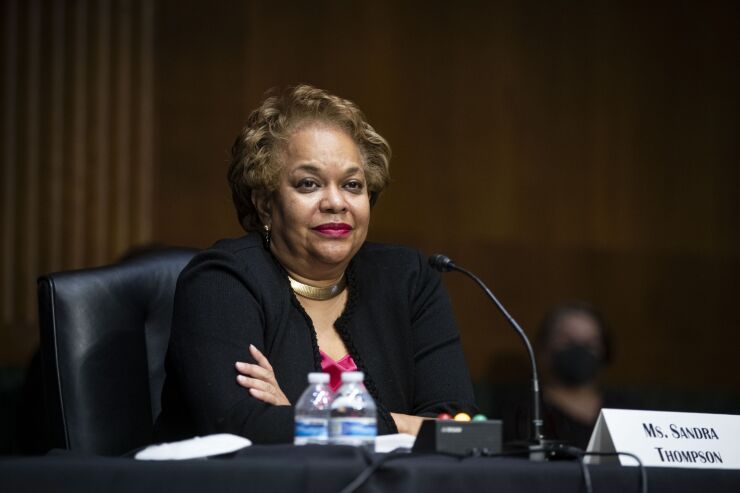
The Federal Housing Finance Agency is wasting no time in demanding changes at the Federal Home Loan banks.
After proposing major reforms in a highly anticipated
The FHFA said Thursday in an
By immediately issuing guidance after the long-awaited report — the first review of the Home Loan Bank System in 90 years — FHFA Director Sandra Thompson is signaling that changes need to be made quickly. The FHFA has long used pilot programs as a way to make changes at government-sponsored enterprises that ultimately become more permanent. The FHFA's guidance is part of a broad effort to get Home Loan banks to deliver public benefits beyond the system's core business of providing
"FHFA believes that the FHLBanks should develop innovative pilot programs, and offer voluntary programs, to increase prudently their support for affordable housing, equity advancement, and community development for underserved and financially vulnerable populations in their districts and other initiatives, including through the FHLBanks' core business activities," the advisory bulletin states.
"Pilot programs or voluntary programs could be designed, for example, to support increases in the supply of affordable single-family and multifamily housing, help close racial homeownership gaps, address residential climate-resiliency improvements, or address other needs," the bulletin states.
Each Home Loan bank must conduct a needs assessment and create board-established prudential parameters with a dollar-volume cap and sunset date for each program, the FHFA said. Each bank's board must establish operating standards to identify the goals, risks and resources needed for each pilot or voluntary program, and management should conduct an assessment of next steps that should be taken if the program becomes permanent. The FHFA also wants each Home Loan bank to publicly post information on the programs on its website.
Separately, the FHFA released a
However, the voluntary contributions the banks make cannot be included in the new pilot or voluntary programs going forward, the FHFA said.
Congress requires that each Home Loan bank contribute at least 10% of net earnings to the Affordable Housing Program. The banks have said that they voluntarily increased their contributions to the Affordable Housing Program to 15% of net earnings. The Home Loan Bank System came under increased scrutiny from lawmakers after the March liquidity crisis laid bare that they were
Cornelius Hurley, an advisor to the Coalition for Federal Home Loan Bank Reform and a former independent director of the Home Loan Bank of Boston, said the banks contribute to voluntary programs to gain political leverage.
"The FHLB System doesn't want Congress to increase the mandatory contribution to AHP to 20%, which is why they are voluntarily increasing it to 15%," Hurley said.
In recent months, the boards of several Home Loan banks including those in Chicago, Cincinnati, New York, Pittsburgh and San Francisco have approved increases to the dividends paid to their members to roughly 8%. The Boston bank raised its dividend this month to 8.3%.
The FHFA has spent the past year conducting a top-to-bottom review of the Federal Home Loan Bank System, which provides liquidity in the form of low-cost loans, known as advances, to 6,500 commercial banks, insurance companies, credit unions and community development financial institutions.
In its report issued Tuesday proposing changes to the system, the FHFA said that it "may propose regulatory changes to correct imbalances in the relative value of the public and private benefits provided by the FHLBank System."
The Home Loan banks receive an implicit U.S. government guarantee on the bonds they issue, which means they can tap the capital markets for more favorable rates on their debt. Critics of the system, including former board members and bankers that are part of the Coalition for Federal Home Loan Bank Reform, claim the private cooperative of financial institutions receives a massive public subsidy because their debt is treated as government debt with privileged status. The banks do not pay federal, state or local taxes, and the interest on their debt is also exempt from state and local taxes.
The system of 11 regional banks was created by the Federal Home Loan Bank Act of 1932 that sought to reinvigorate the housing markets devastated by the Great Depression.






